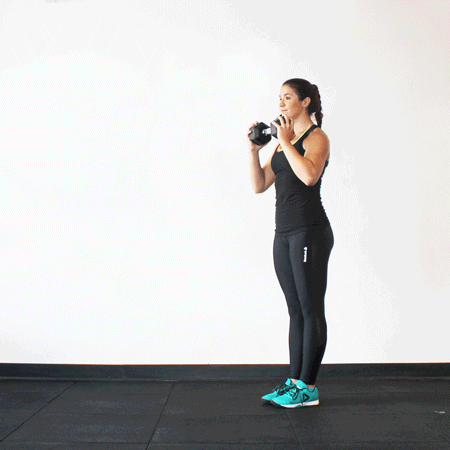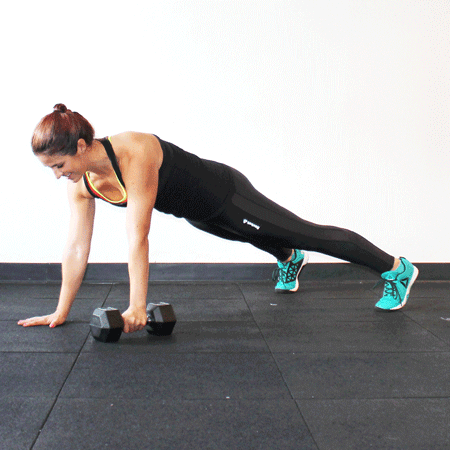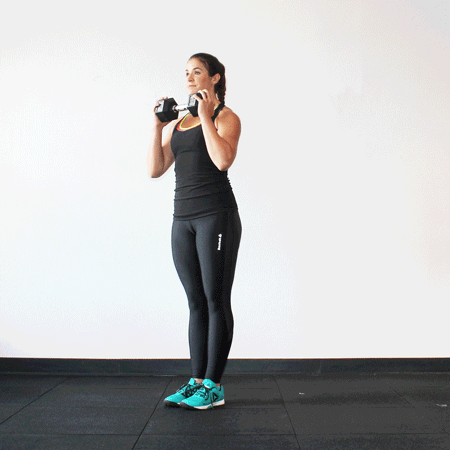The Full-Body Workout You Can Do With One Dumbbell
Tone and strengthen every muscle, from your inner thighs to your shoulders, with this 20-minute routine.

You'll need one heavy dumbbell for this 5-move, total body workout created by Alexandra Ellis, an instructor at CityRow and a certified personal trainer at Equinox in New York. You'll be doing 40 seconds of each move followed by 20 seconds of rest—grab a weight that's heavy enough so that you really need that rest period. "For an intermediate fitness level, that could be anywhere between 8 pounds and 20 pounds," says Ellis. "Leave the 5s on the rack."
How it works
Do 40 seconds of Move 1; rest for 20 seconds; do 40 seconds of Move 2; rest for 20 seconds. Repeat with moves 3, 4 and 5. That's one circuit. Do the circuit a total of 4 times. If you're at a beginner fitness level, take a 60-to-90-second rest between circuits. Otherwise, jump right into the next circuit.
Move 1—Alternating Lunge with Overhead Press

1. Standing with legs together, pick up the dumbbell by both ends and bend your elbows so you're holding the dumbbell at chest height. To keep your shoulders back and down throughout the move, imagine you're squeezing a pencil between your shoulder blades. You want to keep your chest open and lifted too. To do that, push in on both sides of the dumbbell like you're trying to squish them together.
2. Step forward with your right leg into a lunge position. Don't let your front knee extend past your front toe.
3. Once both legs are at 90-degree angles, push your weight into your front heel like you're pushing your foot through the floor to return to standing position.
4. Once standing, lift the dumbbell directly over your head. Your biceps should be in line with your ears, not in front of them, and your elbows should be straight.
5. Bring the dumbbell back to chest height and repeat with your left leg.
Make it easier—Do reverse lunges instead of forward lunges, which, Ellis says, are more difficult balance-wise.
Make it harder—Instead of immediately returning your front foot to the floor when you come out of the lunge, do a front-knee raise first for an additional balance challenge.
Move 2—Alternating Renegade Plank Rows

1. Get into a plank position with one hand on the floor and the other gripping the dumbbell on the floor. Both ends of the dumbbell should be on the floor and you should be holding on in between them. Keep your wrist straight and stacked right under your shoulder. Spread your feet out wide for support (if you're doing this on a yoga mat, they should be at the outside edges of the mat) and with the hand that's on the ground, spread your fingers wide and make sure your wrist is right underneath your shoulder.
2. Lift the dumbbell off the floor and toward your chest by bending your elbow and driving it straight up toward the ceiling. Keep your arm close to your body the whole time. Only bring the weight to chest height—no higher. As you're lifting the dumbbell, try not to let your shoulders or hips move.
3. Lower the dumbbell back to the ground, then transfer the dumbbell to the other hand, either by rolling it or picking it up and moving it.
4. Repeat the row on the other side.
Make it easier—Do planks on your knees instead. Just make sure you're maintaining a straight line between your shoulders, hips and knees, says Ellis—don't let your hips move backwards into a tabletop position.
Make it harder—Add a pushup between rows. (Do one row with each arm, then the pushup, and repeat.)
Move 3—Sumo Squat with Front Shoulder Raise

1. Spread your feet wider than shoulder width apart and turn your toes out to a 45-degree angle. Hold each end of the dumbbell in one hand and let your arms extend down in front of you.
2. Squat down and push your hips back like you're going to sit in a chair. Lower down until your knees are at 90-degree angles. As you're squatting down, keep your arms straight and lift the weight up and out in front of you, until the dumbbell is at shoulder height. Don't let your shoulders shrug up as you raise the dumbbell—keep them down and back.
3. As you lower the dumbbell back to starting position, come out of the squat by squeezing your glutes and your inner thighs and pushing your weight through your heels.
Make it easier—If raising a dumbbell out in front of you is too hard, hold it in at chest height throughout the move instead.
Make it harder—Use a heavier dumbbell or increase your speed through the move while still maintaining control and balance.
Move 4—Plank with Dumbbell Pull-Through

1. Get into a plank position with both hands on the floor, fingers spread wide and feet spread wide like in Move 2—Alternating Renegade Plank Rows. Place the dumbbell on the floor behind your right hand.
2. Without letting your shoulders or hips shift, lift your left hand off the floor, reach it across and under your upper body, grab the dumbbell and move it behind where your left hand was. Return your left hand to the floor. You should really feel this in your core if you're keeping your hips and shoulders in place.
3. Repeat, using your right hand to move the dumbbell back to its original position.
Make it easier—Do the plank on your knees instead. As in Move 2, make sure your hips stay in line with your shoulders and knees.
Make it harder—Add a pushup between pull-throughs.
Move 5—Alternating Lateral Lunge and Reach to Bicep Curl

1. Stand with your feet together, dumbbell at your chest, with one end of the dumbbell in either hand.
2. Keeping your left leg straight, take a big step out to your right. Push your hips back as you lower down into a lateral lunge, making sure that your right knee and toes are pointing straight ahead and your knee doesn't extend past your toes. As you're lunging down, extend your arms and reach the dumbbell toward your right foot. Only reach as far as you can without letting your shoulders cave forward.
3. Push off your right foot and come back to start, keeping your arms and the dumbbell extended toward the floor. When you're back in standing position, do a bicep curl, keeping your elbows glued to your sides, to bring the dumbbell back to your original starting position.
4. Repeat on your left side.
Make it easier—If the lateral lunges are too difficult, start with your feet out wide and instead of lunging, hinge from your hips to reach the dumbbell toward the floor, then stand back up to do the bicep curl.
Make it harder—Rather than bringing your lunging foot back to the floor as soon as you stand up straight, bend it and lift your knee out in front of you for a balance challenge.
How it works
Do 40 seconds of Move 1; rest for 20 seconds; do 40 seconds of Move 2; rest for 20 seconds. Repeat with moves 3, 4 and 5. That's one circuit. Do the circuit a total of 4 times. If you're at a beginner fitness level, take a 60-to-90-second rest between circuits. Otherwise, jump right into the next circuit.
Move 1—Alternating Lunge with Overhead Press

1. Standing with legs together, pick up the dumbbell by both ends and bend your elbows so you're holding the dumbbell at chest height. To keep your shoulders back and down throughout the move, imagine you're squeezing a pencil between your shoulder blades. You want to keep your chest open and lifted too. To do that, push in on both sides of the dumbbell like you're trying to squish them together.
2. Step forward with your right leg into a lunge position. Don't let your front knee extend past your front toe.
3. Once both legs are at 90-degree angles, push your weight into your front heel like you're pushing your foot through the floor to return to standing position.
4. Once standing, lift the dumbbell directly over your head. Your biceps should be in line with your ears, not in front of them, and your elbows should be straight.
5. Bring the dumbbell back to chest height and repeat with your left leg.
Make it easier—Do reverse lunges instead of forward lunges, which, Ellis says, are more difficult balance-wise.
Make it harder—Instead of immediately returning your front foot to the floor when you come out of the lunge, do a front-knee raise first for an additional balance challenge.
Move 2—Alternating Renegade Plank Rows

1. Get into a plank position with one hand on the floor and the other gripping the dumbbell on the floor. Both ends of the dumbbell should be on the floor and you should be holding on in between them. Keep your wrist straight and stacked right under your shoulder. Spread your feet out wide for support (if you're doing this on a yoga mat, they should be at the outside edges of the mat) and with the hand that's on the ground, spread your fingers wide and make sure your wrist is right underneath your shoulder.
2. Lift the dumbbell off the floor and toward your chest by bending your elbow and driving it straight up toward the ceiling. Keep your arm close to your body the whole time. Only bring the weight to chest height—no higher. As you're lifting the dumbbell, try not to let your shoulders or hips move.
3. Lower the dumbbell back to the ground, then transfer the dumbbell to the other hand, either by rolling it or picking it up and moving it.
4. Repeat the row on the other side.
Make it easier—Do planks on your knees instead. Just make sure you're maintaining a straight line between your shoulders, hips and knees, says Ellis—don't let your hips move backwards into a tabletop position.
Make it harder—Add a pushup between rows. (Do one row with each arm, then the pushup, and repeat.)
Move 3—Sumo Squat with Front Shoulder Raise

1. Spread your feet wider than shoulder width apart and turn your toes out to a 45-degree angle. Hold each end of the dumbbell in one hand and let your arms extend down in front of you.
2. Squat down and push your hips back like you're going to sit in a chair. Lower down until your knees are at 90-degree angles. As you're squatting down, keep your arms straight and lift the weight up and out in front of you, until the dumbbell is at shoulder height. Don't let your shoulders shrug up as you raise the dumbbell—keep them down and back.
3. As you lower the dumbbell back to starting position, come out of the squat by squeezing your glutes and your inner thighs and pushing your weight through your heels.
Make it easier—If raising a dumbbell out in front of you is too hard, hold it in at chest height throughout the move instead.
Make it harder—Use a heavier dumbbell or increase your speed through the move while still maintaining control and balance.
Move 4—Plank with Dumbbell Pull-Through

1. Get into a plank position with both hands on the floor, fingers spread wide and feet spread wide like in Move 2—Alternating Renegade Plank Rows. Place the dumbbell on the floor behind your right hand.
2. Without letting your shoulders or hips shift, lift your left hand off the floor, reach it across and under your upper body, grab the dumbbell and move it behind where your left hand was. Return your left hand to the floor. You should really feel this in your core if you're keeping your hips and shoulders in place.
3. Repeat, using your right hand to move the dumbbell back to its original position.
Make it easier—Do the plank on your knees instead. As in Move 2, make sure your hips stay in line with your shoulders and knees.
Make it harder—Add a pushup between pull-throughs.
Move 5—Alternating Lateral Lunge and Reach to Bicep Curl

1. Stand with your feet together, dumbbell at your chest, with one end of the dumbbell in either hand.
2. Keeping your left leg straight, take a big step out to your right. Push your hips back as you lower down into a lateral lunge, making sure that your right knee and toes are pointing straight ahead and your knee doesn't extend past your toes. As you're lunging down, extend your arms and reach the dumbbell toward your right foot. Only reach as far as you can without letting your shoulders cave forward.
3. Push off your right foot and come back to start, keeping your arms and the dumbbell extended toward the floor. When you're back in standing position, do a bicep curl, keeping your elbows glued to your sides, to bring the dumbbell back to your original starting position.
4. Repeat on your left side.
Make it easier—If the lateral lunges are too difficult, start with your feet out wide and instead of lunging, hinge from your hips to reach the dumbbell toward the floor, then stand back up to do the bicep curl.
Make it harder—Rather than bringing your lunging foot back to the floor as soon as you stand up straight, bend it and lift your knee out in front of you for a balance challenge.



